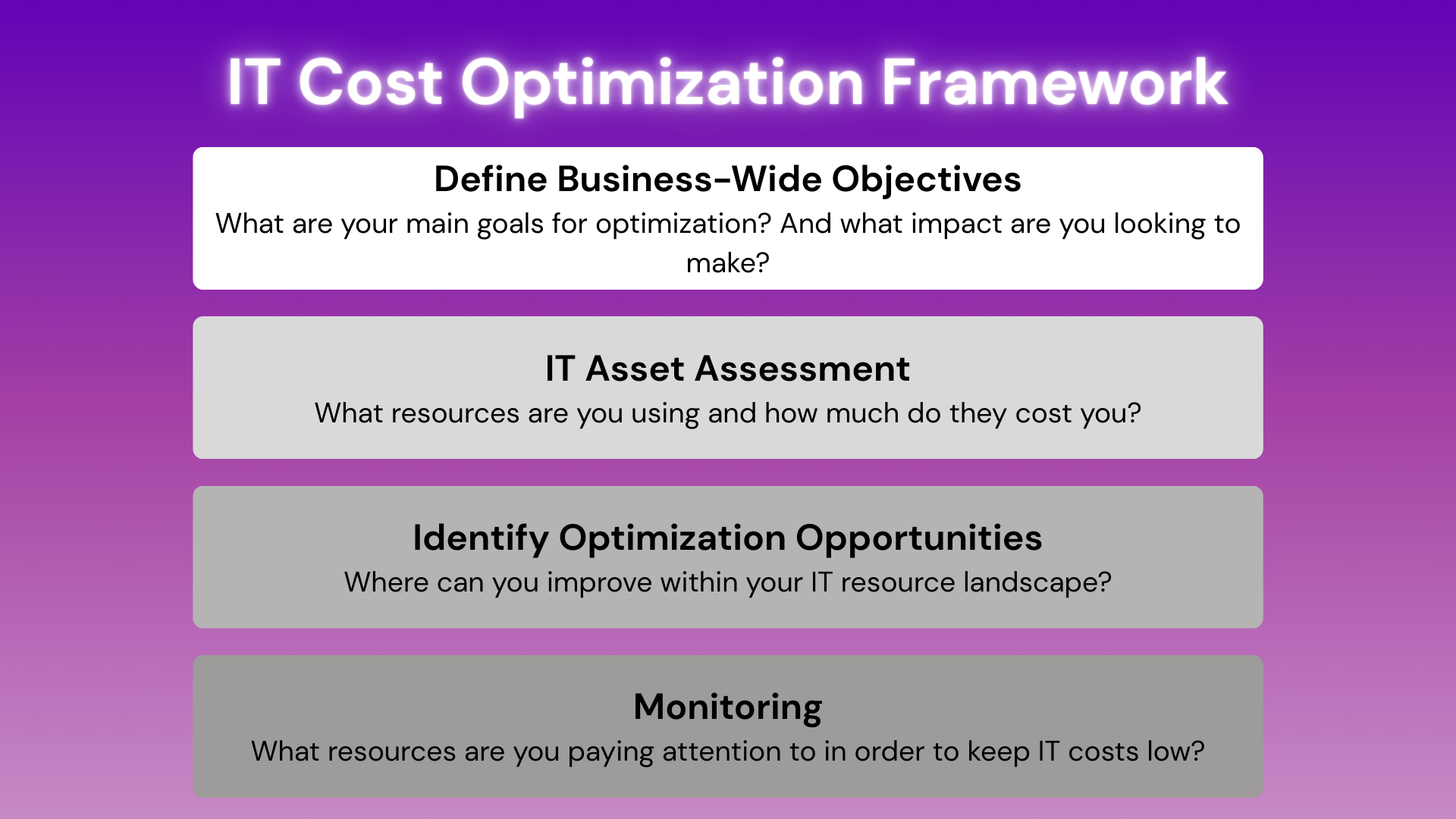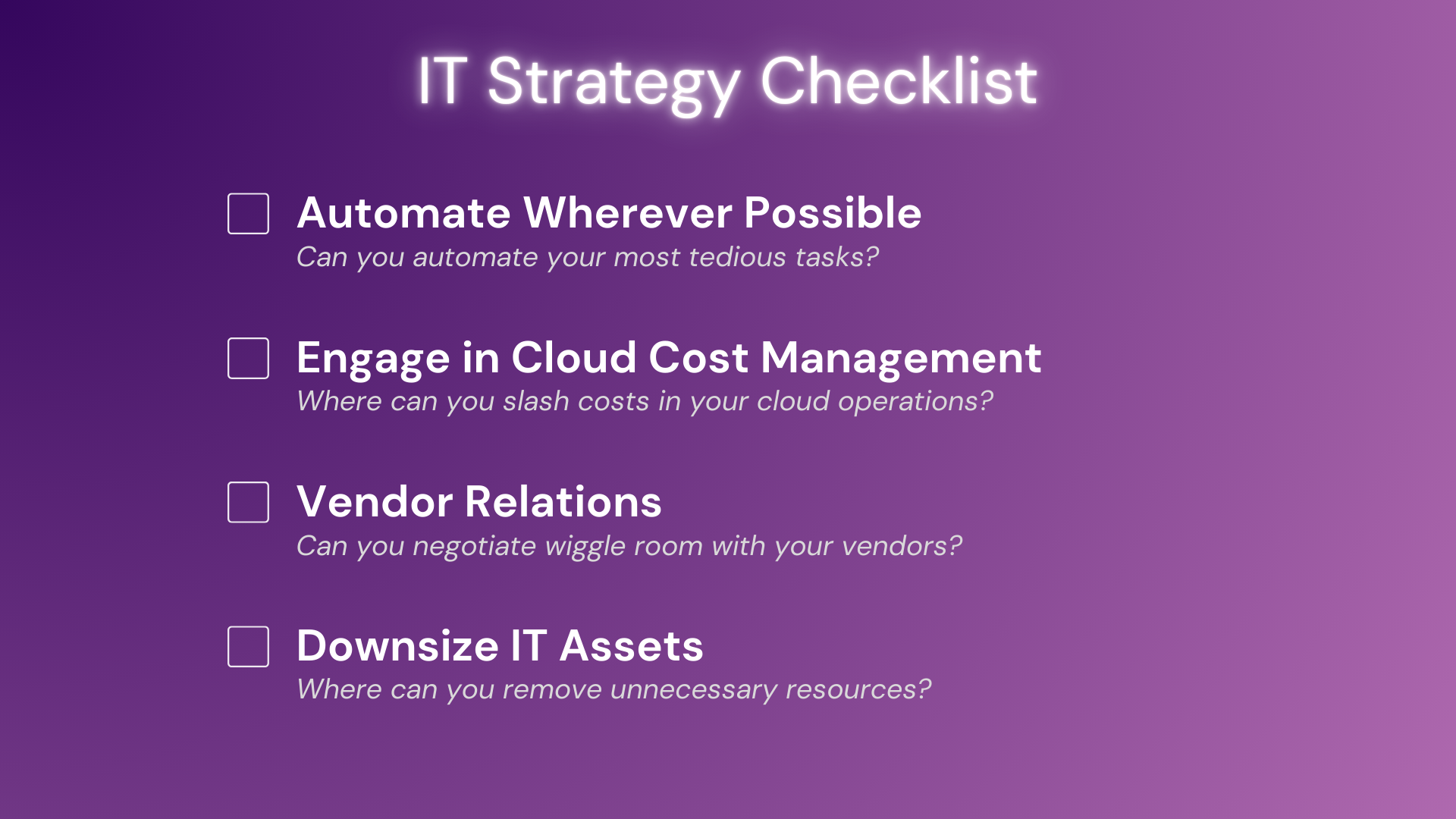Approaching IT Cost Optimization with Lyrid



IT Cost Optimization in 2025
As humans, we LOVE to optimize things. Whether it's prepping meals on one day to save time throughout the week, or waking up earlier to achieve more before work, we constantly strive to make progress towards improving efficiency. And that’s no different when it comes to saving money too.
Many, if not all, companies use some form of IT service throughout their operations, including cloud computing, networking security, and more. And most companies can agree that IT services can be costly at times. Our human desire for optimization has led to the culmination of one of the tech industry’s biggest priorities: IT cost optimization.
As the name suggests, IT cost optimization refers to the practice of driving down IT costs through various activities and changes to operations. This organization-wide practice aims to not only drive down spending, but also optimize current IT assets and practices, increasing organizational longevity.
Optimizing costs have obvious benefits, such as increased cost savings and increased profitability, but can also generate benefits as a result of 360-degree optimization, such as:
- Increased monitoring and visibility / cost transparency
- Reduced system complexity
- Increased efficiency and scalability
- Reduced resource utilization risks
With these benefits coming as a result of total IT system enhancement.
Despite the generalized adjustments that IT cost optimization requires and the benefits that optimizing produces, working towards optimized operations and costs is very nuanced and varies by company and product. However, there are different strategies and frameworks that companies can use to optimize their IT approach.
IT Cost Optimization Framework
Before diving into IT cost optimization efforts and before even enacting a strategy, it is important to have a solid framework of guidance. An IT cost optimization framework will evaluate the impact of optimization strategies on every facet of your organization, from revenue and finances, to operations and teams. Although frameworks may vary from company to company, this framework presents a generalized approach to cost optimization:
Define Business-wide Objectives
This step actually requires two steps:
- Stakeholder Consulting: Be sure to collaborate with stakeholders to establish a clear desired outcome as well as the steps needed to achieve so. Work towards establishing processes, timeframes, and key figures involved in this process.
- Defining Objectives: After consulting with stakeholders, defining clear objectives for optimization is key. Keeping stakeholder requirements in mind, what do you hope to achieve from optimization? Decrease in spending? Increase in efficiency? Objective will largely be dependent on organizational need.
These business goals, both stakeholder and organizational, will act as the guiding principles of your IT cost optimization efforts.
IT Asset Assessment
IT cost optimization requires a full evaluation of an organization’s entire IT asset list, including:
- Hardware and software
- Cloud services
- Infrastructure
- Applications
In this step, not only should organizations map out their assets, but they should also be noting impact, usage, and degradation risks for each asset. Will removing a certain application be worth the reduction in spending? How will reducing usage for a certain application impact operations as a whole?
Be sure to stay up to date with your current IT landscape.
Outside of knowing your assets and the impact they have on your operations. It is necessary to know exactly how much they cost.
This process will take time and require collaboration between different teams and key stakeholders, but financial transparency in IT will reveal required costs, opportunities for optimization, and financial sinks. Auditing IT costs will also show which IT assets provide the most business value, a key metric when allocating funds.
Keep in mind that IT asset assessment, both inventory-wise and cost-wise, will be on-going processes- optimization is a continuous process that may become easier with time and experience.
Identify Optimization Opportunities
Financial transparency will reveal areas of growth within your organization’s IT landscape. From upgrading applications and systems that are currently underprovisioned, to degrading certain systems that might be eating up too many resources, to even totally stopping certain practices, optimization is everywhere. This may even require moving your cloud operations to something that embraces hybrid cloud infrastructure- with this migration being something that Lyrid can help with.
Monitoring
With any change in strategy or adjustment to tech stack, activity and usage should be closely monitored to gauge impact and operation. Monitoring can also help keep costs under control, allowing teams to only use the resources they need- no more, no less.

IT Cost Optimization Strategies
Objectives are only as good as the strategies used to achieve them, and with IT cost optimization, strategies revolve around resource optimizing. Some industry standard strategies to streamline cost optimization initiatives include:
Automating Wherever Possible
Automating, especially repetitive and somewhat laborious tasks, frees up important development time and resources that can be used somewhere else. Automation and AI also reduce human error when it comes to critical tasks like testing and development, further reducing the cost of a mistake. Furthermore, automated monitoring and scaling can automatically adjust resource allocation, allowing teams to intervene and adjust before over/underprovisioning.
Cloud Cost Management
A large part of IT spend is cloud spend, and we all know that cloud resources are not the cheapest thing ever. Cloud cost management, or cloud cost optimization, sees businesses manage their cloud costs through resource optimizing. This is extremely similar to IT cost optimization, but only focused on cloud!
When it comes optimizing your cloud spend, there are widely-regarded tactics that have since become industry standard- such as:
- Rightsizing: Analyzing your current cloud loadout and resources and modifying both to ensure that your application only uses what it needs
- Using Cloud Discounts: Specifically within reserved instances and spot instances
- Using Multiple Clouds
If you’re interested in learning about cloud cost optimization and even different components of your cloud bill, check out Lyrid’s guide on optimizing cloud spend.
Vendor Relations
As concrete as cloud and IT spend seems, there is actually some wiggle room depending on your vendor. Depending on factors like level of commitment, services used, and amount of data stored (just to name a few), organizations are able to negotiate better contracts. In fact, if you are unhappy with your service some vendors may even upgrade your service!
When approaching hybrid cloud or on-premise infrastructure, local data centers that have better relations with utility providers can provide more competitive pricing due to better energy pricing on their end. These data centers offer enterprise-level hardware and service at a fraction of the enterprise cost, a huge factor of consideration when it comes to optimizing IT costs.
Downsize IT Assets
Perhaps the simplest of these strategies is to downsize the assets that do not serve you anymore. Older systems, hardware, and licenses can create clutter within your IT approach, not only increasing costs but also complexity. There are tons of alternatives to legacy systems that can not only reduce waste and costs, but also promote scalability and futureproofing, giving your organization the greatest bang for their buck.

Lyrid - IT Cost Optimization for SMBs
Spending money on IT resources is a necessary evil- while an application is highly dependent on software, that same software can be driving up your costs rapidly as usage grows. In fact, one of the biggest IT spend contributors, cloud computing, is actively burning money (roughly 32% of your total cloud spend) due to improperly managed data transfers, both over and underprovisioned resources, and, in general, unoptimized operations.
At Lyrid, we are hyperfocused on providing the best hardware and services at prices affordable for the masses, and we do so through:
Managed Kubernetes
Lyrid Managed Kubernetes offers cloud setup optimizing and Kubernetes features and benefits without the additional headache of Kubernetes. Typically, operating Kubernetes yourself would not only require professionals, but also time and resources to manage its backend. With our Managed Kubernetes solution, users can access the strong features of Kubernetes, including:
- Automated scaling
- Automated container distribution
- Streamlined cluster management
- Automated health checks
For the cost of one solution. Our cluster analysis also encourages IT cost optimizing by automatically adjusting your resource usage to eliminate wasted spending.
Global Data Center Network
The Lyrid Global Data Center Network is one that prioritizes partnerships and community rather than fund-maximizing. That being said, it helps that through this network, we’re able to negotiate and offer users competitive prices for bare metal hardware located around the world!
We partner with local data centers to provide lower latency, better hardware, and faster support, allowing users and companies working with us to access worldwide hardware and markets. That being said, many of our data center partners have great relations with their utility providers, giving them an advantage through flexible pricing. This flexibility translates to user access to hardware, giving you the best price possible on bare metal resources.
Data center leaders can also partner with us directly to bring their services worldwide.
Cost Transparency
One of the most important aspects of IT cost reduction is being able to see where your money goes. We heavily believe in the importance of cost visibility and real time monitoring, with the Lyrid platform offering both capabilities to best serve your optimization efforts.
Our platform offers end-to-end cluster visibility, monitoring and management tools, and resource scaling capabilities all in one platform. Additionally, our AI-driven algorithm offers expense predictions for projects, clusters, and deployments through our universal metrics, as well as automated instance matching based on app requirements and specified costs.
And this is just the tip of the iceberg.

To learn more about how Lyrid can optimize your IT landscape and cut costs, try us out for free, or book a demo with one of our product specialists!











